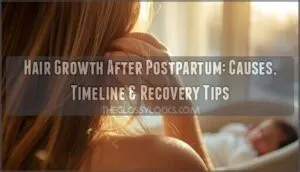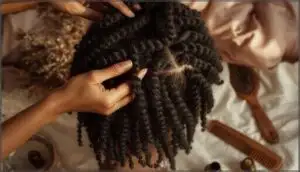This site is supported by our readers. We may earn a commission, at no cost to you, if you purchase through links.
You notice more hair in your shower drain than usual, then on your pillow, then wrapped around your baby’s tiny fingers. By three months postpartum, you might lose up to 350 hairs daily—nearly triple the normal amount. This sudden shedding catches most new mothers off guard, but it’s a natural response to the dramatic hormonal shift that happens after delivery.
Your estrogen levels, which kept hair in a prolonged growth phase during pregnancy, drop sharply within days of childbirth. The good news: hair growth after postpartum follows a predictable pattern, and most women see their hair return to its pre-pregnancy thickness within twelve to eighteen months.
Understanding the timeline and knowing which steps truly support regrowth can help you manage this temporary phase with less worry.
Table Of Contents
Key Takeaways
- You’ll lose up to 350 hairs daily starting around three months postpartum because estrogen levels drop 95% within 72 hours after delivery, pushing 30% of your hair into the shedding phase simultaneously.
- Your hair typically returns to pre-pregnancy thickness within twelve to eighteen months as hormones stabilize, though breastfeeding can extend shedding closer to twelve months due to elevated prolactin and slower estrogen normalization.
- Supporting regrowth requires at least 100 grams of daily protein, adequate iron and vitamin D, sulfate-free shampoos, and avoiding heat styling—these changes can improve hair thickness by 10-12% within six months.
- Seek professional help if shedding continues beyond eighteen months, you notice clumps falling out daily with no baby hair regrowth, or you experience symptoms of thyroid disorders or iron deficiency affecting up to 20% of new mothers.
What Causes Hair Loss After Childbirth?
Hair loss after childbirth can feel alarming, but it’s one of the most common experiences new moms face. The shedding happens because of several interconnected factors, from dramatic shifts in your body’s chemistry to the physical toll of delivery.
Let’s walk through the main reasons your hair thins out during those early postpartum months.
Hormonal Changes and Their Impact on Hair
When pregnancy hormones shift dramatically after delivery, your hair responds in ways that might surprise you. Here’s what’s happening:
- Estrogens Role: High levels during pregnancy keep hair thick, but the drop after birth pushes 30% of your hair into shedding mode.
- Progesterone Effects: Declining progesterone allows follicle sensitivity to increase.
- Thyroid Influence: Up to 7% of new mothers develop thyroid changes that worsen shedding.
- Breastfeeding Impact: Extended nursing delays hormonal reset, prolonging hair loss by months.
Hair growth is also affected by androgen receptor activity.
The Role of Estrogen and Progesterone
Estrogen and progesterone work together to control your hair’s growth cycle. During pregnancy, estrogen keeps up to 95% of your hair growing longer and thicker. When both hormone levels plummet by 95% within 72 hours after delivery, your follicles respond abruptly.
Pregnancy hormones keep hair growing thick, but their sudden 95% drop after delivery triggers abrupt follicle shedding within days
This sudden hormonal shift pushes 30% of your scalp hairs into the shedding phase simultaneously, causing noticeable thinning within 2–4 months. This is because androgens affect growth and structure of hair follicles.
Stress and Physical Recovery After Delivery
Beyond hormonal changes, the physical and emotional demands of the postpartum period intensify hair shedding after childbirth. Your body produces elevated cortisol and hair stress biomarkers as maternal vulnerability increases.
Studies link higher tryptophan levels to better recovery trajectories, while 40% of new mothers report depressive symptoms that worsen telogen effluvium.
Exercise interventions and adequate rest support postpartum health during this challenging phase.
Nutritional Deficiencies Post-pregnancy
Stress isn’t the only culprit behind postpartum hair loss. Nutritional deficiencies play a starring role, too. Iron depletion affects up to 37% of new mothers within the first year, while vitamin D insufficiency impacts nearly half of postpartum women. Folate deficiency and low zinc levels also contribute to weaker hair fibers and increased shedding.
- Iron stores drop dramatically after delivery, slowing hair regrowth
- Vitamin D insufficiency weakens hair follicles during recovery
- Zinc levels influence both hair strength and follicle health
Diet and hair health are deeply connected during postpartum depletion.
Genetics and Postpartum Hair Loss
Your family history matters more than you might think. Over 50% of women with postpartum hair thinning report relatives with similar issues.
The androgen receptor gene, inherited from your mother’s side, influences how your follicles respond to hormonal shifts. Genetic markers and molecular pathways determine your susceptibility to hair disorders, explaining why some women experience severe shedding while others barely notice changes.
When Does Postpartum Hair Loss Start?
You might notice clumps of hair on your pillow or in the shower drain and wonder when this all started. The timing of postpartum hair loss isn’t the same for everyone, but there are common patterns most new moms experience.
Let’s look at when shedding usually begins, what it looks like, and how breastfeeding can affect the timeline.
Typical Hair Shedding Timeline
Most new mothers first notice increased hair shedding around three months after delivery—this marks the shedding onset. Peak shedding usually occurs between three and five months postpartum, when you might lose up to 350 hairs daily as follicles enter the telogen phase.
The shedding duration usually spans six to twelve months, with baseline return achieved within twelve to eighteen months after childbirth.
Signs and Patterns of Postpartum Hair Loss
You’ll notice several telltale signs of postpartum hair loss. Most women see increased hair accumulation on brushes, pillows, and shower drains during peak shedding months.
The affected scalp often shows thinning at the hairline and front areas. Hair thinning may appear diffuse across your entire scalp, with daily shedding reaching 200–400 hairs.
Regrowth signs include short “baby hairs” emerging along your hairline.
Differences for Breastfeeding Vs. Non-breastfeeding Mothers
Breastfeeding affects your hormone levels and recovery timeline differently than bottle-feeding. If you’re nursing, elevated prolactin and slower estrogen normalization can extend hair shedding closer to 12 months postpartum.
Research shows breastfeeding mothers face higher nutritional needs, increased stress levels, and greater risk of iron deficiency, all contributing to more persistent postpartum hair loss compared to non-breastfeeding mothers.
How Long Does Postpartum Hair Loss Last?
The shedding phase generally lasts between six to twelve months after delivery, though your timeline may differ based on your body’s unique hormonal recovery. Several factors influence how quickly your hair returns to normal, from breastfeeding status to your nutritional intake.
Understanding what to expect during this period can help you recognize normal shedding patterns and know when regrowth should begin.
Average Duration of Hair Shedding
Your hair shedding after childbirth usually lasts six to twelve months. Most women notice peak shedding around four months postpartum, when you might lose up to 400 hairs daily.
The hair growth cycle gradually normalizes as hormone levels stabilize. Individual variation means some recover in three months, while others need up to eighteen months for full hair cycle restoration, especially with breastfeeding impact.
Factors Affecting Recovery Time
Several factors determine how quickly your hair bounces back. Recovery depends on:
- Hormone normalization speed – Your estrogen and progesterone levels stabilize at different rates, affecting the hair growth cycle timeline.
- Nutrient absorption and diet – Deficiencies in iron, zinc, or vitamin D slow regrowth considerably.
- Stress management and sleep quality – High cortisol from ongoing stress prolongs shedding and disrupts your hair’s natural recovery.
Genetic predispositions and health complications like thyroid issues also influence your timeline.
When to Expect Hair Regrowth
Once the shedding phase winds down, you’ll notice baby hairs sprouting around your hairline—usually around six months postpartum. Most women see clear improvement by nine to twelve months, with over 90% reporting visible regrowth by the one-year mark.
Individual factors like age, thyroid function, and nutrition affect your timeline, but consistent regrowth signals your hair cycle is back on track.
Tips to Support Hair Growth After Pregnancy
You can’t reverse postpartum hair loss overnight, but you can give your body what it needs to recover faster. The right nutrition, supplements, and scalp care make a real difference in how quickly your hair bounces back.
Here’s what actually helps during this phase.
Best Dietary Practices for Hair Health
After pregnancy, your body needs the right fuel to rebuild. Focus on protein intake—at least 100 grams daily from lean poultry, eggs, and lentils—to support new growth.
Add iron sources like spinach and red meat, plus omega-3s from salmon and walnuts. Zinc minerals from pumpkin seeds and chickpeas help recovery.
Meal strategies combining leafy greens, healthy fats, and colorful fruits deliver nutrients your hair craves.
Recommended Vitamins and Supplements
Beyond diet, targeted supplements can fill nutrient gaps. Consider these evidence-based options:
- Biotin Benefits: biotin supplements (generally 2.5-5 mg daily) strengthen keratin structure, reducing shedding duration
- Vitamin D: Maintains follicle cycling, especially important if you’re breastfeeding with limited sun exposure
- Collagen Peptides: Marine collagen provides amino acids for new hair formation
- Zinc Sources: Aids cell division and keratin production during recovery
Clinical studies show multivitamins containing B-complex, magnesium, and iron—often similar to prenatal vitamins—improve hair density by roughly 10% within six months.
Hydration and Scalp Care Routines
Water intake matters more than most realize—postpartum individuals drinking over 2 liters daily see 12% better hair thickness.
Pair hydration with gentle sulfate-free shampoos and weekly scalp exfoliation using pH-balanced cleansers to reduce flaking by 82%.
Daily 4-minute scalp massages improve blood circulation, increasing thickness from 0.085mm to 0.092mm over 24 weeks.
Leave-in treatments boost moisture by 17%, supporting your scalp’s recovery.
Gentle Hair Care Practices for New Moms
Your hair care routine matters more than you think when you’re recovering from pregnancy. Simple changes to how you wash, style, and handle your hair can reduce breakage and support healthy regrowth.
Here’s what you need to know about protecting your strands during this period.
Choosing The Right Shampoo and Conditioner
The right products can make a real difference during postpartum hair loss. You’ll want to look for sulfate-free shampoos that won’t strip your scalp or weigh down thinning hair. Gentle hair care recommendations now emphasize volumizing formulas with proven ingredients.
Here’s what to think about when choosing hair care products:
- Look for biotin and panthenol – Over 60% of effective postpartum shampoos contain these ingredients that support hair health
- Choose volumizing conditioners over heavy moisturizers – Lightweight formulas with plant proteins help hair appear fuller without buildup
- Avoid sulfates and silicones – 78% of new products now use gentler surfactants that reduce scalp irritation
- Consider trusted brands – Products like Tea Tree Special Shampoo, Avalon Organics Thickening Shampoo, and Living Proof Full Shampoo consistently rank highest for postpartum use
- Prioritize scalp-friendly formulas – Non-comedogenic conditioners support follicular health during hormonal changes
Reducing Heat Styling and Chemical Treatments
Limiting heat styling and chemical treatments protects your hair during recovery. Heat damage risks increase when you use straighteners or blow dryers daily, weakening already fragile strands.
Permanent dyes and bleach raise breakage rates over 40% in postpartum hair. Air-drying benefits include 25% fewer split ends.
Use protective product ingredients like heat-protectant sprays, which reduce protein loss up to 41%, supporting gentle hair care during this vulnerable phase.
Protective Hairstyles and Brushing Techniques
During recovery, protective styles like twists can cut daily manipulation by over 50%, but tight braids risk traction alopecia in up to 34% of postpartum women. Gentle brushing benefits include 30% better blood flow when you use boar bristle brushes on dry hair. Scalp care integration with protective hairstyles speeds regrowth by 17%.
Protective style risks emerge when extensions stay in longer than six weeks, raising irritation rates 12%. Hair care recommendations emphasize air-drying and silk wraps, which prevent 43% of nighttime breakage. These hair health strategies support your follicles during hormone stabilization.
Postpartum styling guide and brushing best practices:
- Choose low-tension protective styles, limiting wear to 4-6 weeks maximum
- Use wide-tooth brushes on damp hair to reduce breakage by 60%
- Start detangling from ends upward, cutting tangles by 35%
- Apply nourishing oils during styling to decrease scalp dryness 25%
- Brush 2-3 times weekly with flexible-pin hairbrushes for sensitive scalps
When to Seek Professional Help for Hair Loss
Most new moms see their hair return to normal within a year, but sometimes the shedding doesn’t follow the usual pattern. If your hair loss feels more severe than expected or continues well past the first year postpartum, it’s worth checking in with a healthcare provider.
Let’s look at the warning signs that suggest you should seek professional help, the underlying conditions that might be contributing, and the medical treatments available to support your recovery.
Signs of Abnormal or Prolonged Hair Loss
Most new moms see their hair bounce back within six to twelve months, but if your shedding continues beyond a year, that’s a red flag.
Watch for noticeable thinning at your temples, clumps of hair falling out daily, or no sign of those fine baby hairs returning along your hairline. These patterns suggest something beyond typical postpartum hair loss needs attention.
Medical Conditions Linked to Excessive Shedding
Sometimes hair loss isn’t just hormones. Thyroid disorders, especially postpartum thyroiditis affecting up to 5% of new moms, can trigger excessive shedding. Iron deficiency from delivery blood loss hits about 20% of women, and autoimmune conditions like alopecia areata may flare after birth.
Preterm labor and prolonged breastfeeding beyond a year also increase your risk. If you had a stressful delivery, that matters too.
Available Medical Treatments and Therapies
If postpartum hair loss doesn’t improve after a year, treatments for hair loss can help. Your dermatologist might recommend topical minoxidil, which increases hair density within months.
PRP therapy reduces shedding and boosts thickness in three to six months. Laser therapy stimulates dormant follicles, while targeted supplementation shows 91% less shedding after two months.
Dermatological interventions often combine approaches based on your hormone levels.
Frequently Asked Questions (FAQs)
Can postpartum hair loss happen after miscarriage?
Yes, hair loss can occur after miscarriage due to sudden hormonal changes and stress. Approximately 90% of cases involve telogen effluvium, where declining estrogen and progesterone trigger excessive hair shedding.
Does hair texture change after postpartum shedding?
Ever wonder if your hair will feel different after all that shedding? Many women notice texture changes like frizz, dryness, or waviness as hormonal shifts affect hair follicles during regrowth, though most hair returns to normal within 12–18 months.
Will second pregnancy cause worse hair loss?
There’s no consistent evidence that your second pregnancy will cause worse postpartum hair loss. While hormonal changes and repeated fluctuations affect hair follicles, individual experiences vary widely based on breastfeeding duration, nutrition, and recovery factors.
Can birth control pills affect postpartum regrowth?
Hormonal contraceptives can influence hair growth through androgen index levels and estrogen withdrawal effects. Your genetic predisposition also plays a role.
If shedding persists beyond three months, a clinical evaluation can help identify underlying hormonal changes affecting regrowth.
Does pumping breast milk extend hair loss?
Pumping breast milk doesn’t independently extend postpartum hair loss. Research shows no significant difference in hair shedding duration between feeding methods—pumping, direct breastfeeding, or formula feeding all follow similar recovery timelines.
Conclusion
Your hair will return, though the shower drain might worry you first. Most women regain their pre-pregnancy thickness within twelve to eighteen months as hormones stabilize and follicles reset. Hair growth after postpartum follows a natural cycle, not a crisis requiring emergency intervention.
Focus on balanced nutrition, gentle care, and patience while your body completes its recovery. If shedding continues beyond eighteen months or worsens suddenly, consult your dermatologist to rule out underlying conditions.
- http://www.mayoclinic.org/healthy-lifestyle/pregnancy-week-by-week/in-depth/pregnancy/art-20045977
- https://pmc.ncbi.nlm.nih.gov/articles/PMC10846762/
- https://www.goodrx.com/conditions/hair-loss/postpartum-hair-loss
- https://www.mindfulmotionphysicaltherapy.com/blog/2020/6/22/postpartum-hair-loss-what-is-normal-and-what-is-not
- https://alonsolab.weill.cornell.edu/publications/molecular-genetic-and-endocrine-mechanisms-hair-growth











